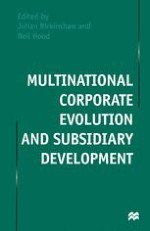1998 | OriginalPaper | Chapter
Centres of Excellence in the International Firm
Authors : Luciano Fratocchi, Ulf Holm
Published in: Multinational Corporate Evolution and Subsidiary Development
Publisher: Palgrave Macmillan UK
Included in: Professional Book Archive
Activate our intelligent search to find suitable subject content or patents.
Select sections of text to find matching patents with Artificial Intelligence. powered by
Select sections of text to find additional relevant content using AI-assisted search. powered by
In the last decade there has been increasing recognition that the international firm (in the strict sense of one with operations in both national and international markets) is organised as a heterogeneous entity built up of subunits with specific operative responsibilities and specific interrelated roles (Hedlund, 1986; Bartlett and Ghoshal, 1989; Nohria and Ghoshal, 1994; Malnight, 1996). Thus, certain subsidiaries within the international firm are regarded as being especially competent in one or several functional areas. For instance, because of its competence with a particular product, a foreign subsidiary can become globally responsible for production. Similarly, another subsidiary can be specialised in the development of a product, while a third can have responsibility for marketing and international sales. Having one or several operational competences — interrelated with the operational roles of other units of the firm — the specific subsidiary can become a strategic ‘partner’ of the firm’s headquarters (Bartlett and Ghoshal, 1989), with potential impact on strategic decisions (Astley and Zajac, 1990; Ghoshal and Bartlett, 1990).
